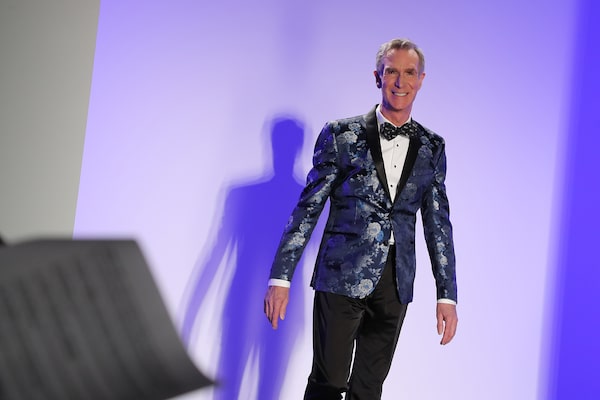
Bill Nye walks the runway at The Blue Jacket Fashion Show during NYFW at Pier 59 Studios on Feb. 5, 2020 in New York City.ROB KIM/Getty Images
In the fall of 2017, menswear designer Nick Graham asked Bill Nye – yes, that science guy – to walk the runway for a space-themed show during New York Fashion Week. The mechanical engineer-turned-beloved 1990s TV geek strutted his stuff wearing a metallic suit with a rocket print and his signature bow tie. It was his first brush with the world of fashion and, as Nye puts it, “it was pretty darn cool.”
The fashion industry is one of the biggest contributors to climate change, accounting for 10 per cent of global carbon emissions. Last week Nye joined forces with another luxury fashion brand, Canada Goose, as an adviser with the outerwear giant to help guide them toward their ambitious goal to be net carbon neutral by 2025.
So now rather than teaching kids about the differences between things like rubidium and radium, he’s joined a team that talks about polymers and PFMs (preferred fibres and material that are more sustainable for the planet). In an interview with the Globe and Mail, Nye explains why he’s hopeful this generation – the same one who grew up watching his TV show – will be the one that saves the planet. Why? Because they accept science as fact, not fiction, and more importantly, they “won’t put up with the climate denial crap I’ve heard for the last 30 years.”
For a nerd, you’re surprisingly stylish, explain how you became interested in fashion?
Well, clearly I’ve always liked bow ties. I own hundreds of them. A few years ago I had a chance meeting with Nick Graham backstage at the [British science-comedy hybrid show] The Infinite Monkey Cage and we just clicked. Nick – who is Canadian, by the way, maybe that’s why I like him – is a guy in the fashion industry who talks all the time about the waste in his business. About how clothes are barely worn before they’re discarded. That good ‘ol Calgary boy had a big influence on me and I wanted to play a role in helping to lower the environmental effect of apparel on the planet.
The fashion industry is responsible for 10 per cent of the world’s carbon emissions. How did it become such a big polluter?
In two words, fast fashion. The upside and the downside of globalization is clothes are made from oil, from polymers, and they are manufactured by people who work for less money than people in the developed world do. On top of that, the supply chains – and the transportation that goes along with them – have been thoroughly dialled in. You can have something delivered from India, Vietnam or China the next day. All of this combined has contributed to making clothes disposable. Combine that with human nature, and the fact people’s tastes change from year to year, and we’ve created a fine stew of waste. The good news is more people are to beginning to see the value in sustainable manufacturing. They’re also beginning to appreciate clothing with longevity. Once more people start choosing quality over quantity we’ll be on our way to making real progress.
Sustainable manufacturing finally seems to be getting its due, which is great, but why did it take so long?
The hardest thing for people to understand, embrace and accept is that everything each one of us does affects everyone else on Earth. We all share the same air … so along this line, everything we do in the manufacturing of anything, especially in the garment industry, affects everyone else in the world. We’ve always acted like we have all the time in the world [to fix things] and we don’t. The world is getting warmer and it’s getting warmer fast. It’s the rate at which the planet is heating up that should keep everyone awake at night. Companies like Canada Goose, which has built a very successful business model by making and selling clothes that last forever, is setting a sustainable example that I hope other [brands] will emulate.
How likely is that?
Providing products that are sustainably produced has become a selling point. They are the products that young people, especially, want to buy. They are also willing to pay more to get them. Once other brands recognize that following a sustainable roadmap can be profitable, it will have a spillover effect. We will get closer to the so-called circular economy, which means when clothing wears out, it gets recycled or reused. It goes back into service, and there will be less waste.
You’ve been warning about the devastating impact of climate change for years and it’s fallen mostly on deaf ears. What’s changed?
In my lifetime, despite all the warnings, climate change has been met with inertia. People have not wanted to accept that big changes are coming and that big changes have to be made. The younger generation is not going to put up with the denial and contrarianism of the generation before them. There’s an old saying, that science moves forward one funeral at a time … and the people who were skeptical of the science, they’re dying off. Young people are not going to put up with the old excuses. The discoveries, the science, is obvious to them. This generation is going to get ‘er done.
So you’re optimistic?
We all have to be. We don’t have a choice. Without optimism we wouldn’t accomplish anything. There are exciting things happening in the world of fashion and consumers are starting to take the environment into account when they buy. We need more companies that are designing for generations, not seasons. It’s smart business that works for the betterment of consumers and our planet.
 Gayle MacDonald
Gayle MacDonald